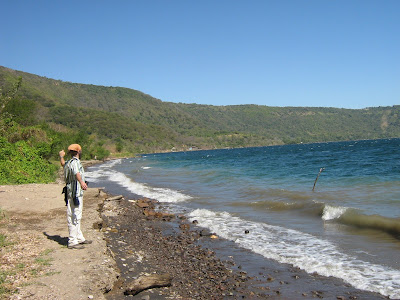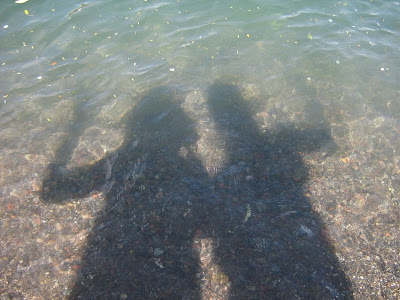We at Estacion Biologica FUNDECI/GAIA have been working a long time in Laguna de Apoyo Nature Reserve. Several years ago, we appealed to the local authorities and the Ministry of Natural Resource and the Environment (MARENA) to provide a presence in the area, which was until the late 1900's, only a paper tiger. People were cutting trees, constructing houses, hunting, boating, and all kinds of other activities which were incompatible with the identity of Laguna de Apoyo as a natural area and, furthermore, illegal.
The area was designated part of the Sistema Nacional de Areas Protegidas in 1991, but this decree did not save the area from the ravenous pressure of unsustainable uses, because there were no park guards nor any other kind of systematic vigilance in the area. Timber cutters, weekend boaters and hunters, and developers had a free-for-all in the area. Dozens of lots were cleared and houses built, including a 65-house development aimed at the US market for timeshares.
While all this was going on, FUNDECI/GAIA was quietly (and at times, not so quietly) working with the community and the local and national government offices to save Laguna de Apoyo as a natural area. Among the first projects executed in this area was the construction of a guardhouse for the reserve, located at the main entrance to the Laguna de Apoyo Nature Reserve on the edge of the volcanic crater.
 |
| Jeffrey McCrary of FUNDECI/GAIA and Cruz Palacios of MARENA at the Laguna de Apoyo guard station. Photo by Rebecca Orr. |
To perform this feat, several negotiations were required. First, MARENA agreed to hire a park guard to provide vigilance in the reserve. Until then, this area had no one to count on for vigilance and control. The mayor of Catarina, Juan Manuel Gallegos, donated a small piece of municipal land for the guardhouse. MARENA supplied a series of design criteria for the guardhouse, also. A local builder, Francisco Aguilar, agreed to perform the construction at a very reasonable cost. The Small Projects Fund of the Canadian Embassy provided part of the financing, the remainder paid by funds from FUNDECI/GAIA and from Patricia and Olga Lopez.
This guardhouse was finished July 6, 2000, approximately one hour before a mortal earthquake destroyed hundreds of houses in Masaya and the Laguna de Apoyo area. The rustic design for our guardhouse, however, held fast, and no more than a crack or two resulted. And the timing was perfect, because the structure was immediately put into use by the authorities in the rescue efforts, as hundreds were evacuated from Laguna de Apoyo Nature Reserve and its vicinity with the participation of the Civil Defense, National Police, and Red Cross.
 |
| Counting birds can not be done at a more pleasing location. Pier-Olivier Boudreault, intern with FUNDECI/GAIA, takes a break by the shore of Lake Apoyo. Photo by Catherine Bard-Duchesneau. |
 |
| Our interns work on their data as dinner is getting prepared. Life is good at Estacion Biologica. Photo by Rebecca Orr. |
Our volunteers and interns work on projects of benefit to the wild nature of Laguna de Apoyo Nature Reserve and the communities in and around the reserve. Some of the projects involve wildlife, other recent projects have included erosion control, reforestation, recycling, and environmental education. Many volunteers and interns also study Spanish at Apoyo Spanish School, which is also located in Estacion Biologica Laguna de Apoyo. Our school is the oldest in Nicaragua, and our teachers have trained the teachers of many other schools in Nicaragua in our successful methodology.
 |
| Our Spanish students sometimes get hands-on experience in Nicaraguan cooking styles. Photo by Rebecca Orr. |
Among our most notable projects is the development and approval of the first management plan for Laguna de Apoyo Nature Reserve. GAIA worked closely with the sponsoring NGO, Liga de Cooperativas de Nicaragua (CLUSA) on contract by MARENA, to collect data and organize community participation in the management plan. There was plenty of opposition to the process, particularly on the part of unscrupulous land developers and real estate brokers, all of which was eventually overcome, and the management plan was approved by MARENA in 2010.
 |
| Some of these trees in our reforestation nursery are grown in re-used plastic milk bags. Photo by Phil Johnson. |
Our guests are invited to help us in the ways that fit best their capacities. Many people actually enjoy "playing in dirt", which is essentially what is entailed by our reforestation project. Each year, we plant hundreds or even thousands of trees in critical points in the Laguna de Apoyo Nature Reserve. Our homegrown trees are produced with compost made from kitchen waste and leaves, and the seeds collected from the natural forest of our reserve. We are not paid by anyone to plant trees, because our intention is not to grow trees for commercially lucrative harvest. Instead, we are re-creating forest where it once was. Planting trees requires a small amount of capital, but lots of labor, so we depend heavily on volunteers. Want to donate your time to make the world a greener place?
.JPG) |
| Swimming in Laguna de Apoyo is beyond words. Photo by Rebecca Orr. |
 |
| Nancite (Byrsonima crassifolia) is a wild fruit of our area, abundant in season and worth a taste. Photo by Jeffrey McCrary. |
We eat well at Estacion Biologica, and sometimes, we even eat from the forest. a variety of chile is native to our forests, and we harvest it in season for our use, from plants which grow right in our yard. Other edible fruits abound, most of them alien to the uninitiated. Learning about the wild fruits which Nicaraguans consume is part of learning about this wonderful country.
 |
| Dawn is gorgeous over the lake, but you must get up to enjoy it. Photo by Catherine Bard-Duchesneau. |
.jpg) |
| You are being watched. Photo by Hans Rademaker. |
Every day we see something new, often something very pleasant, about Laguna de Apoyo Nature Reserve. For instance, howler monkeys once were a rare sight at Estacion Biologica, as they generally stayed at least 500 meters away. The forests have improved in the past decade, thanks to numerous conservation measures implemented in the reserve; now we have them in the yard practically every day. We are not far from the city, but the nature is still here, and we are working to keep it that way. Want to help? Please contact us.
 |
| Click on the "escudo" to contact us. |

1 comment:
http://gaianicaragua.org/station.html
Check out this site for more information.
Post a Comment